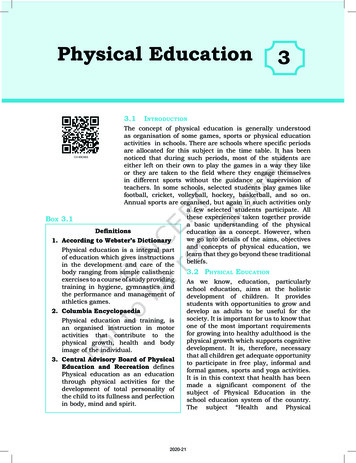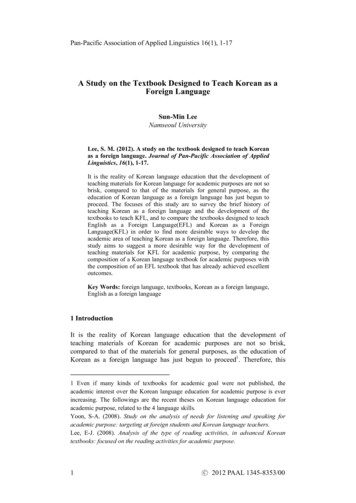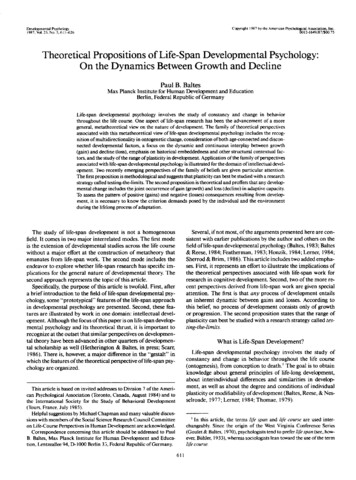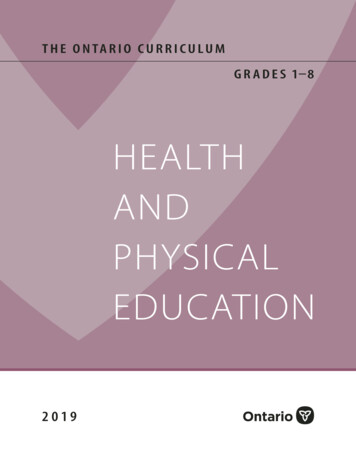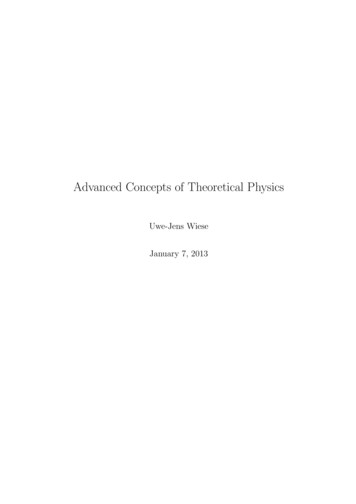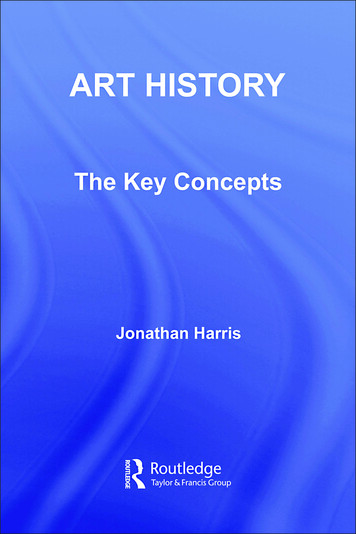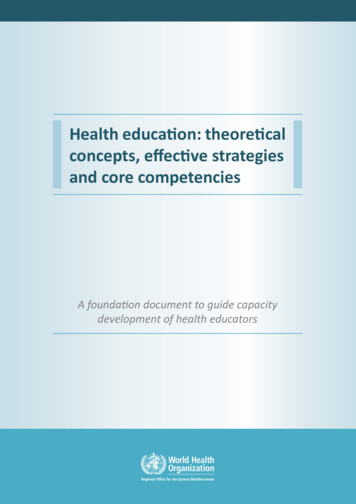
Transcription
Health education: theoreticalconcepts, effective strategiesand core competenciesA foundation document to guide capacitydevelopment of health educators
Health education: theoreticalconcepts, effective strategiesand core competenciesA foundation document to guide capacitydevelopment of health educators
WHO Library Cataloguing in Publication DataWorld Health Organization. Regional Office for the Eastern MediterraneanHealth education: theoretical concepts, effective strategies and core competencies: a foundation document to guide capacitydevelopment of health educators/World Health Organization. Regional Office for the Eastern Mediterraneanp.ISBN: 978-92-9021-828-9ISBN: 978-92-9021-829-6 (online)1. Health Education - methods - Eastern Mediterranean Region 2. Health Promotion - Eastern Mediterranean Region 3. HealthLiteracy 3. Competency-Based Education I. Title II. Regional Office for the Eastern Mediterranean(NLM Classification: WA 590) World Health Organization 2012All rights reserved.The designations employed and the presentation of the material in this publication do not imply the expression of any opinionwhatsoever on the part of the World Health Organization concerning the legal status of any country, territory, city or area or ofits authorities, or concerning the delimitation of its frontiers or boundaries. Dotted lines on maps represent approximate borderlines for which there may not yet be full agreement.The mention of specific companies or of certain manufacturers’ products does not imply that they are endorsed orrecommended by the World Health Organization in preference to others of a similar nature that are not mentioned. Errors andomissions excepted, the names of proprietary products are distinguished by initial capital letters.All reasonable precautions have been taken by the World Health Organization to verify the information contained in thispublication. However, the published material is being distributed without warranty of any kind, either expressed or implied. Theresponsibility for the interpretation and use of the material lies with the reader. In no event shall the World Health Organizationbe liable for damages arising from its use.Publications of the World Health Organization can be obtained from Distribution and Sales, World Health Organization, RegionalOffice for the Eastern Mediterranean, PO Box 7608, Nasr City, Cairo 11371, Egypt (tel: 202 2670 2535, fax: 202 2670 2492;email: PAM@emro.who.int). Requests for permission to reproduce, in part or in whole, or to translate publications of WHORegional Office for the Eastern Mediterranean—whether for sale or for noncommercial distribution—should be addressed toWHO Regional Office for the Eastern Mediterranean, at the above address: email: WAP@emro.who.int .Printed by WHO Regional Office for the Eastern Mediterranean, Cairo
ContentsPreface. 5Acknowledgements. 6Executive summary. 71. Background and purpose. 112. Definition of key terms. 133. Examining the relationships: health education, health promotion and health literacy. 15Health education and health promotion. 15Relationship between health education and health literacy. 174. Health behaviour theories, models and frameworks. 19How are health behaviour theories useful?. 19What are the most common behaviour theories that health educators use?. 215. Health education planning, implementation and evaluation: examples of effectivestrategies and barriers to success. 39Examples of effective health education initiatives and strategies—systematic reviews. 40Challenges to implementing health education and prevention programmes. 456. Health education core competencies. 48Health education settings. 48Health education responsibilities and competencies. 497. Health education code of ethics. 528. Conclusion. 53Annex 1. Explanation of key definitions. 54Annex 2. Complete list of health educator competencies. 66Annex 3. Code of ethics for the health education profession. 72References. 76
Health education: theoretical concepts, effective strategies and core competenciesPrefaceHealth education as a tool for health promotion is critical for improving the health of populationsand promotes health capital. Yet, it has not always received the attention needed. The limitedinterest stems from various factors, including: lack of understanding of health education by thoseworking in this field; lack of knowledge of and consensus on the definitions and concepts ofhealth education and promotion; and the difficulty health educators face in demonstrating theefficiency and showing tangible results of the practice of health education. Of course, there aremany success stories relating to health education, particularly in the settings approach, such ashealth-promoting schools, workplaces, clinics and communities. However, where boundaries arenot well defined, implementing health education becomes more challenging.The WHO Regional Office for Eastern Mediterranean conducted a situation analysis to assessthe health education capacity, programmes and activities in Member States of the Region. Thefindings of the assessment showed a number of persisting challenges. These include access toand knowledge of up-to-date tools that can help educators engage in effective health educationpractice, and confusion about how health education can meaningfully contribute to the goals ofhealth promotion.This publication is intended to fill the gaps in knowledge and understanding of health educationand promotion and provide Member States with knowledge of the wide range of tools available.As a health education foundation document, it provides a review of the various health educationtheories, identifies the components of evidence-based health education, outlines the competenciesnecessary to engage in effective practice, and seeks to provide a common understanding of healtheducation disciplines and related concepts. It also offers a framework that clarifies the relationshipbetween health literacy, health promotion, determinants of health and healthy public policy andhealth outcomes. This can be useful in understanding better the assets and gaps in the applicationof health promotion and education. It is targeted at health promotion and education professionalsand professionals in related disciplines.
Health education: theoretical concepts, effective strategies and core competenciesAcknowledgementsThis publication is the product of contributions by many individuals. The publication was writtenand revised by Wayne Mitic, Victoria University, Canada and Faten Ben Abdelaziz and Haifa Madi,WHO Regional Office for the Eastern Mediterranean, Cairo. The draft was reviewed by a technicalcommittee comprising representatives of technical partners and Member States, including JaffarHussain and Akihiro Seita, WHO Regional Office for the Eastern Mediterranean, Cairo. Technicalcontributions were also received from Abdelhalim Joukhader, Senior Consultant, Mayada Kanj,American University of Beirut, Gauden Galea, WHO Regional Office for Europe and StephenFawcett, WHO Collaborating Centre for Community Health and Development, University of Kansas.6
Health education: theoretical concepts, effective strategies and core competenciesExecutive summaryHealth education forms an important part of the health promotion activities currently occurringin the countries that make up the WHO Eastern Mediterranean Region. These activities occur inschools, workplaces, clinics and communities and include topics such as healthy eating, physicalactivity, tobacco use prevention, mental health, HIV/AIDS prevention and safety. Staff who arerecognized as “health educators” are hard-working, enthusiastic and dedicated. However, a numberof challenges exist, including having access to appropriate up-to-date tools on how to engage ineffective health education practice and confusion as to how health education can meaningfullycontribute to the goals of health promotion. In response to these challenges, a number of ministryof health staff within the Region have expressed a need for more clearly defined roles and updatedskills in health education practice. The purpose of this foundation document is to fill those gaps. Itreviews health education theories and definitions, identifies the components of evidence-basedhealth education and outlines the abilities necessary to engage in effective practice.Much has been written over the years about the relationship and overlap between healtheducation, health promotion and other concepts, such as health literacy. Attempting to describethese various relationships is not easy; discussion of these concepts can be intense since theprofessional affiliation associated with them is often strong and entrenched and the concepts areeither still evolving or have evolved at different times from separate disciplines.Health promotion is defined by the Ottawa Charter as the process of enabling people to increasecontrol over and to improve their health. For the purposes of this document, health promotionis viewed as a combination of health education activities and the adoption of healthy publicpolicies. Health education focuses on building individuals’ capacities through educational,motivational, skill-building and consciousness-raising techniques. Healthy public policies providethe environmental supports that will encourage and enhance behaviour change. By influencingboth individuals’ capacities and providing environmental support, meaningful and sustainedchange in the health of individuals and communities can occur. Health literacy is an outcome ofeffective health education, increasing individuals’ capacities to access and use health informationto make appropriate health decisions and maintain basic health.Each year vast resources are spent in the Eastern Mediterranean Region trying to modify humanbehaviour. While some interventions are successful, many fall short of their goals. Researchshows that those interventions most likely to achieve desired outcomes are based on a clearunderstanding of targeted health behaviour and the environmental context in which theyoccur. For help with developing, managing and evaluating these interventions, health educationpractitioners can turn to several planning models that are based on health behaviour theories.The major planning theories and models currently being used by health educators include thefollowing. The rational model This model, also known as the “knowledge, attitudes, practices model”(KAP), is based on the premise that increasing a person’s knowledge will prompt a behaviourchange. The health belief model One of the earliest behaviour change models to explain human healthdecision-making and subsequent behaviour is based on the following six constructs: perceivedsusceptibility, severity, benefits and barriers, cues to action and self-efficacy.7
Health education: theoretical concepts, effective strategies and core competencies The extended parallel process model Based on the health belief model, this model proposesthat people, when presented with a risk message, engage in two appraisal processes: adetermination of whether they are susceptible to an identified threat and whether the threatis severe; and whether the recommended action can reduce that threat (i.e. response efficacy)and whether they can successfully perform the recommended action (i.e. self-efficacy). The transtheoretical model of change Behaviour change is viewed as a progression through aseries of five stages: pre-contemplation, contemplation, preparation, action and maintenance.People have specific informational needs at each stage, and health educators can offer themost effective intervention strategies based on the recipients’ stage of change. The theory of planned behaviour The theory holds that intent is influenced not only by theattitude towards behaviour but also the perception of social norms (the strength of others’opinions on the behaviour and a person’s own motivation to comply with those of significantothers) and the degree of perceived behavioural control. The activated health education model This is a three-phase model that actively engagesindividuals in the assessment of their health (experiential phase); presents information andcreates awareness of the target behaviour (awareness phase); and facilitates its identificationand clarification of personal health values and develops a customized plan for behaviourchange (responsibility phase). Social cognitive theory According to this theory, three main factors affect the likelihoodthat a person will change health behaviour: self-efficacy, goals and outcome expectancies.If individuals have a sense of self-efficacy, they can change behaviour even when faced withobstacles. Communication theory This theory holds that multilevel strategies are necessary dependingon who is being targeted, such as tailored messages at the individual level, targeted messagesat the group level, social marketing at the community level, media advocacy at the policy leveland mass media campaigns at the population level. Diffusion of innovation theory This theory holds that there are five categories of people:innovators, early adopters, early majority adopters, late majority adopters and laggards; andthe numbers in each category are distributed normally: the classic bell curve. By identifyingthe characteristics of people in each adopter category, health educators can more effectivelyplan and implement strategies that are customized to their needs.Given the numerous health education initiatives that have occurred over the past 30 to 40 years, themultiple target groups and issues that have been addressed, and the differing evaluation methodsthat have been used, one is left with the question: what are the core ingredients of success?The following methods have stood the test of time and appear to be essential components ofhealth education programmes and services aimed at enhancing an individual’s and a community’shealth. Participant involvement Community members should be involved in all phases of aprogramme’s development: identifying community needs, enlisting the aid of communityorganizations, planning and implementing programme activities, and evaluating results. Planning This involves identifying the health problems in the community that are preventablethrough community intervention, formulating goals, identifying target behaviour and8
Health education: theoretical concepts, effective strategies and core competenciesenvironmental characteristics that will be the focus of the intervention efforts, deciding howstakeholders will be involved, and building a cohesive planning group. Needs and resources assessment Prior to implementing a health education initiative, attentionneeds to be given to identifying the health needs and capacities of the community and theresources that are available. A comprehensive programme The programmes with the greatest promise are comprehensive,in that they deal with multiple risk factors, use several different channels of programmedelivery, target several different levels (individuals, families, social networks, organizations,the community as a whole) and are designed to change not only risk behaviour but also thefactors and conditions that sustain this behaviour (e.g. motivation, social environment). An integrated programme A programme should be integrated: each component of theprogramme should reinforce the other components. Programmes should also be physicallyintegrated into the settings where people live their lives (e.g. worksites). Long-term change Health education programmes should be designed to produce stable andlasting changes in health behaviour. This requires longer-term funding of programmes and thedevelopment of a permanent health education infrastructure within the community. Altering community norms In order to have a significant impact on an entire organization orcommunity, a health education programme must be able to alter community or organizationalnorms and standards of behaviour. This requires that a substantial proportion of thecommunity’s or organization’s members be exposed to programme messages or, preferably,be involved in programme activities in some way. Research and evaluation A comprehensive evaluation and research process is necessary, notonly to document programme outcomes and effects, but to describe its formation and processand its cost-effectiveness and benefits.The US National Commission for Health Education Credentialing (NCHEC) has identified sevenmajor responsibilities for the health educator as well as the competencies and sub-competenciesthat demonstrate competency under each responsibility. The major responsibilities for healtheducators are: assessing individual and community needs for health education planning effective health education programmes implementing health education programmes evaluating the effectiveness of health education programmes communicating health and health education needs, concerns and resources coordinating the provision of health education services acting as resource people in health education.The NCHEC has proposed a profession-wide standard code of ethics for health educators. A codeof ethics provides a framework of shared values within which health education is practised. Theresponsibility of each health educator is to aspire to the highest possible standards of conductand to encourage the ethical behaviour of all those with whom they work. Regardless of job title,professional affiliation, work setting or population served, health educators should abide by theseguidelines when making professional decisions.9
Health education: theoretical concepts, effective strategies and core competencies Responsibility to the public A health educator’s ultimate responsibility is to educate peoplefor the purpose of promoting, maintaining and improving individual, family and communityhealth. Responsibility to the profession Health educators are responsible for their professionalbehaviour, for the reputation of their profession and for promoting ethical conduct amongtheir colleagues. Responsibility to employers Health educators recognize the boundaries of their professionalcompetence and are accountable for their professional activities and actions. Responsibility in the delivery of health education Health educators promote integrity inthe delivery of health education. They respect the rights, dignity, confidentiality and worthof all people by adapting strategies and methods to the needs of diverse populations andcommunities. Responsibility in research and evaluation Health educators contribute to the health of thepopulation and to the profession through research and evaluation activities. Responsibility in professional preparation Those involved in the preparation and training ofhealth educators have an obligation to accord learners the same respect and treatment givenother groups by providing quality education that benefits the profession and the public.In conclusion, health education, as one component to the broader area of health promotion,provides a valuable contribution to the betterment of individual and community health. Thisfoundation document provides a thorough review of theories and tools in the areas of healtheducation and health promotion and related disciplines. The ultimate goal is to provide a commonunderstanding. The health educator who uses targeted, theory-based interventions, embracesconcepts of participation and voluntary change, and includes health literacy and individualcapacity-building within health programmes and services, is a valuable and essential member ofthe health promotion team.10
Health education: theoretical concepts, effective strategies and core competencies1.Background and purposeThroughout the WHO Eastern Mediterranean Region many healtheducation-related activities occur in schools, workplaces, clinics andcommunities. A wide range of topics is covered, including healthyeating, physical activity, tobacco use prevention, mental health, HIV/AIDS prevention and safety. Staff who are recognized as “healtheducators” are hard-working, enthusiastic and dedicated even thoughthey often work with limited budgets and lack the kind of recognitiongiven to those serving in other parts of the health services system.Health educatorsare hard-working,enthusiasticand dedicatedprofessionalsThe path to a comprehensive health education initiative in the Region is filled with additionalsignificant challenges. Health education activities are taking place throughout the Region but much of this effortappears to be restricted to the production of materials and presentations for the purposeof raising public awareness of health-related issues. Not only is this approach limiting but itseffectiveness has, to date, not been thoroughly assessed or reported in the Region. Many health educators are often expected to divide their time between their own workand projects involving the broader aspects of health promotion (i.e. public policies, healthyenvironments, cross-government initiatives). Many health educators have limited specialized training and therefore have, in some cases,restricted their activities to social marketing and information-dissemination strategies. Oftenthey lack an understanding of the theoretical foundations of health education and the ways inwhich these theories and concepts can be applied. Many health educators do not have access to the tools requiredto be effective practitioners; to engage in needs/capacityassessments, plan comprehensive health behaviour changeinitiatives and assess programme impacts. Confusion exists in the relationship between health educationand the broader area of health promotion. The ways in whichhealth educators can meaningfully contribute to the goals ofhealth promotion are not well defined.Confusion existsin the relationshipbetween healtheducation activitiesand the broader areaof health promotionIn response to these challenges, a number of ministry of health staff within the countries of theRegion have started expressing a need for more clearly defined roles and updated skills in healtheducation practice.The purpose of this foundation document is to begin a process of reviewing and strengtheninghealth education capacity in the countries of the Region. Specifically, the document will focus onthe following: the role of health educators and their importance key health behaviour change theories and models examples of evidence-based health education initiatives11
Health education: theoretical concepts, effective strategies and core competencies core health education skills and competencies the relationship among health education and other components of the health-promotingsystem.12
Health education: theoretical concepts, effective strategies and core competencies2.Definition of key termsDefinitions provide people with a common foundation for understanding. Most people recognize,for example, the importance of adopting “healthy behaviour” and living in “healthy environments”.However, the difficulty arises in the interpretation of health-related terms, which can vary greatlyamong different professional groups and segments of society. The following definitions arepresented to enhance effective communication and therefore the understanding of the modelsand frameworks presented later. A more detailed description of each of these terms is providedin Annex 1.HealthThe WHO Constitution of 1948 defines health as a state ofDefinitions provide peoplecomplete physical, social and mental well-being, and notwith a common foundationmerely the absence of disease or infirmity. In addition, thefor understandingOttawa Declaration states an “individual or group must beable to identify and realize aspirations, to satisfy needs, andto change or cope with the environment. Health is, therefore,seen as a resource for everyday life, not the objective of living. Health is a positive conceptemphasizing social and personal resources, as well as physical capacities”. (1)Health education“Consciously constructed opportunities for learning involving some form of communicationdesigned to improve health literacy, including improving knowledge, and developing life skills,which are conducive to individual and community health.” (2) The WHO health promotion glossarydescribes health education as not limited to the dissemination of health-related information butalso “fostering the motivation, skills and confidence (self-efficacy) necessary to take action toimprove health”, as well as “the communication of information concerning the underlying social,economic and environmental conditions impacting on health, as well as individual risk factorsand risk behaviours, and use of the health care system”. A broad purpose of health educationtherefore is not only to increase knowledge about personal health behaviour but also to developskills that “demonstrate the political feasibility and organizational possibilities of various forms ofaction to address social, economic and environmental determinants of health”.Health literacy“The degree to which people are able to access, understand, appraise and communicateinformation to engage with the demands of different health contexts in order to promote andmaintain good health across the life-course.” (3)Health promotion“The process of enabling people to increase control over, and to improve, their health.” (1)13
Health education: theoretical concepts, effective strategies and core competenciesLifestyle (lifestyles conducive to health)“A way of living based on identifiable patterns of behaviour which are determined by the interplaybetween an individual’s personal characteristics, social interactions, and socioeconomic andenvironmental living conditions.” (2)Population risk continuumThe health of all people in a community can be considered as a health continuum between optimalhealth and death. Where ones lies on the continuum is related to many risk factors and conditionsoften referred to as the determinants of health (i.e. social and economic environment, individualcapacity and coping skills, personal health practices, health services, biology and genetics).The quality of our lives and therefore our health is influenced by our physical, economic andsocial environments. As well, personal behaviour that places us at risk (e.g. eating few fruits andvegetables) increases the chance of developing health problems (e.g. many types of cancer).Prevention“Measures not only to prevent the occurrence of disease, but also arrest its progress and reduceits consequences once it is established.” (4)Primary health care“Essential health care based on practical, scientifically sound and socially acceptable methods andtechnology made universally accessible to individuals and families in the community through theirfull participation and at a cost that the community and country can afford.” (5) In many countriesprimary health care involves incorporating curative treatment given by the first-contact provideralong with promotional, preventive and rehabilitative services provided by multidisciplinary teamsof health care professionals working collaboratively. (6,7)Quality of Life“An individual’s perceptions of their position in life in the context of the culture and value systemwhere they live, and in relation to their goals, expectations, standards, and concerns.” (8)WellnessThe optimal state of health of individuals and groups; involves the realization of the fullest physical,psychological, social, spiritual and economical potential of an individual: the fulfilment one’s roleexpectations in the family, community, place of worship, workplace and other settings. (9)14
Health education: theoretical concepts, effective strategies and core competencies3. Examining the relationships: health education, healthpromotion and health literacyMuch has been written over the years about the relationship, uniqueness and overlap betweenhealth education, health promotion and other concepts, such as health literacy, primary healthcare, community development and mobilization, and the role of empowerme
reviews health education theories and definitions, identifies the components of evidence-based health education and outlines the abilities necessary to engage in effective practice. Much has been written over the years about the relationship and overlap between health education, heal





